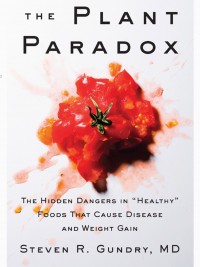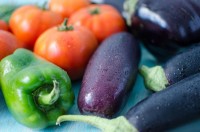Lectins
Not all people have lectin problems, but those that do have plenty of it.
Lectins Edible Enemies
"SO, WHAT ARE lectins anyway? For the most part, with one important exception, they are large proteins found in plants and animals, and they are a crucial weapon in the arsenal of strategies that plants use to defend themselves in their ongoing battle with animals. Scientists discovered lectins in 1884 as part of their investigation into different blood types. Until now, you have probably been familiar with only one famous—or, rather, infamous—lectin: gluten. There are many more, and soon I'll introduce you to the most important of these—and believe me, you'll want to know them. (Just as a teaser, 94 percent of humans are born with antibodies to the lectin in peanuts.)
How exactly do lectins help plants defend themselves? Well, lectins in the seeds, grains, skins, rinds, and leaves of most plants bind to carbohydrates (sugars), and particularly to complex sugars called polysaccharides, in the predator's body after it consumes the plant. Like smart bombs, lectins target and attach themselves to sugar molecules, primarily on the surface of the cells of other organisms—particularly fungi, insects, and other animals.
They also bind to sialic acid, a sugar molecule found in the gut, in the brain, between nerve endings, in joints, and in all bodily fluids, including the blood vessel lining of all creatures. Lectins are sometimes referred to as "sticky proteins" because of this binding process, which means they can interrupt messaging between cells or otherwise cause toxic or inflammatory reactions,10 as we'll discuss later. For example, when lectins bind to sialic acid, one nerve is unable to communicate its information to another nerve. If you haveever experienced brain fog, thank lectins. Lectins also facilitate the attachment and binding of viruses and bacteria to their intended targets. Believe it or not, some people—those who are more sensitive to lectins—are therefore more subject to viruses and bacterial infections than others. Think about that if you seem to get sick more often than your friends do.
In addition to the potential to cause health problems, lectins can also stimulate weight gain. The reason that wheat became the grain of choice in northern climates is thanks to a uniquely small lectin in wheat, known as wheat germ agglutinin (WGA), which is responsible for wheat's weight-gaining propensity. You read that correctly. Wheat helped your ancestors gain or maintain weight in ancient times when food was often scarce; back then, a "wheat belly" was a great thing to possess! And guess what? That WGA in the "ancient" forms of wheat is just as present in modern wheat—hence the weight gain. We will explore these implications further in the following chapters.
A plant will do just about anything to keep your mouth off its seeds and save its babies, including sacrificing its leaves. By design, lectins either kill any animal that dares to eat it outright or at the very least make that animal feel unwell. After all, a weakened enemy is more vulnerable. Assuming they survive their initial encounter with such a plant, insects and other animals quickly learn not to eat any plant (or its seeds) that makes them feel bad or fail to thrive. The animal decides that that plant is not worth eating and moves on to greener fields and other species, while the plant and its babies survive. Again, it's a win-win situation and the détente prevails.
Ancient humans developed a host of ways to deal with lectins. Unfortunately, modern humans aren't so savvy. Instead, if we eat something that doesn't agree with us or makes us sick, we find or invent something—think Nexium, a stomach-acid reducer, or a drug such as ibuprofen that lessens pain—so we can continue to eat a substance designed to destroy, cause pain in, or at least weaken us.
Speaking of stomach acid, get this: Not only do we keep eating foods that are designed to hurt us, but we also feed them to animals in the food chain, which suffer similarly from their diet. Left to their own devices, cows would never consume corn and soybeans—their natural diet is grasses and other forage—but that is exactly what they are fed on industrial farms. The lectins in corn and soy are far more effective than grass in making the cow heavier and giving them a better ratio of fat. (That same corn and grain in processed foods bulk you up as well, as you will learn in chapter 5.) Both soy and corn are laden with lectins foreign to cows, causing them to develop such severe heartburn and pain in swallowing that they actually stop eating. Yes, cows develop heartburn from these lectins, just as you do. To keep their beasts eating more of this fattening food, farmers dose them with calcium carbonate, the active ingredient in Tums.11 In fact, half of the world's production of this compound is added to cattle feed to stop the heartburn, ensuring that cows continue to eat their unnatural diet of corn and soybeans."
Excerpt From The Plant Paradox. Dr. Steven R. Gundry, M.D.
This material may be protected by copyright.
https://gundrymd.com/lectins-history/
https://gundrymd.com/common-lectins/
https://gundrymd.com/lectins-definition/
Nightshades and inflammation
Nightshades contain lectins.
Despite being damaging to us if we eat them untreated, nightshades when properly processed are safe. I know three safe methods (when applicable) to remove lectins from nightshades:
1. Peeling and deseeding (tomatoes, peppers, etc).
2. Cooking them in pressure cooker for about 20 minutes reduce lectins over 20 times.
3. Fermentation.
The nightshade list:
- tomatoes (all varieties, including tomatillos)
- potatoes (all varieties, NOT sweet potatoes or yams)
- eggplant (aubergine)
- okra
- peppers (all varieties such as bell pepper, wax pepper, green & red peppers, chili peppers, cayenne, paprika, etc.)
- goji berries
- tomarillos (a plum-like fruit from Peru)
- sorrel
- garden huckleberry & blueberries (contain the alkaloids that induce inflammation)
- gooseberries
- ground cherries
- pepino Melon
- tobacco
- paprika
- cayenne pepper
Soy sauce made in the U.S. is generally made with genetically modified (GMO) soy beans, which are cut with the nightshade plant Petunia.
The condiments black/white pepper and pepper corns are not nightshades
Cashew and peanuts are not nightshades but contain too much lectins and cause inflammation. Especially bad are cashews.
http://www.greenmedinfo.com/blog/link-between-nightshades-chronic-pain-and-inflammation


